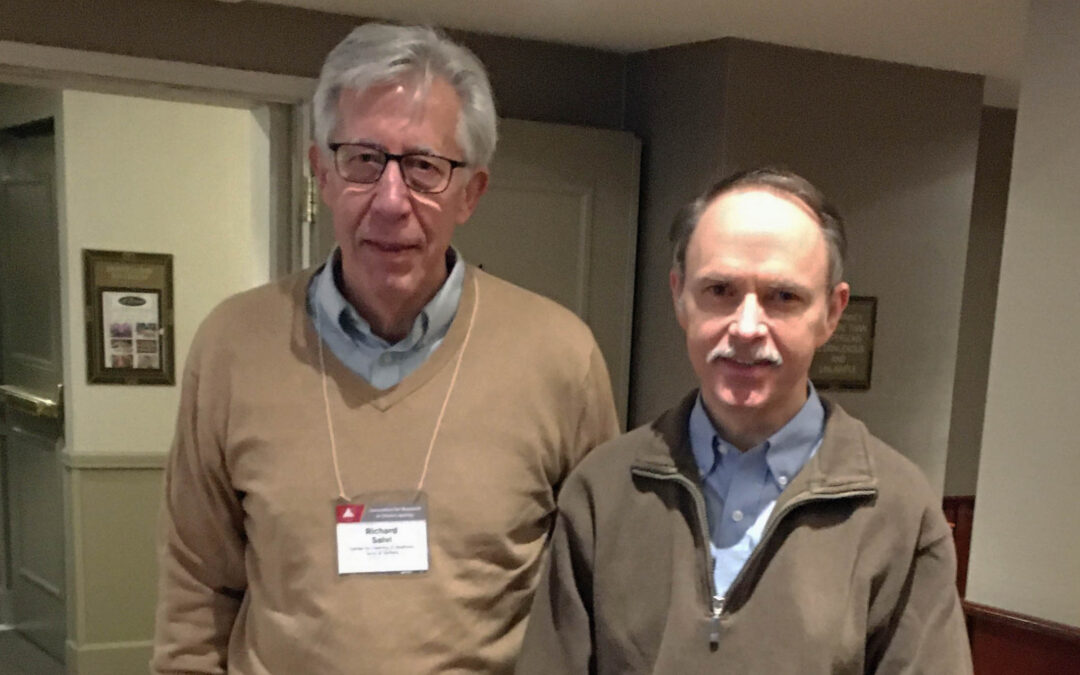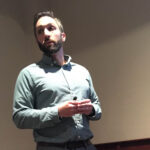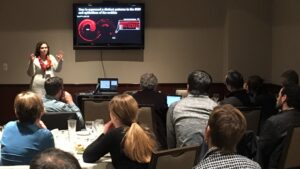Hyperacusis Research was grateful to participate in the 2020 Association of Research for Otolaryngology Midwinter meeting just before the pandemic struck the United States.
Pictured at top: Bryan Pollard and Richard Salvi, PhD, Hyperacusis Research Scientific Advisor
Many significant collaborative connections were made with researchers throughout ARO, which culminated in the 2020 Hyperacusis Alliance dinner event. Along with presentations of a patient story and the latest research, the event focused on determining the top 20 research priorities for hyperacusis.
A doctor shared his insights into his wife’s hyperacusis journey which started well over a decade ago. The details of her story can be found on our website here. His unique insights helped researchers understand the complexity of hyperacusis and its interactions with other medical conditions. His wife also shared her personal experiences by video. Most importantly, her condition improved by Low-Level Laser Therapy (LLLT). The doctor emphasized two key points:
– Clinicians need to understand the importance of learning and practicing compassionate communication.
– We need to leverage the power and experience of patients in research priorities, design, interpretation and dissemination.
Ben Auerbach, PhD, Assistant Professor of Molecular and Integrative Physiology, University of Illinois at Urbana-Champaign, spoke about his work on Hypersensitivity in Autism (which was completed at the University at Buffalo). Ben started by describing how sensory hypersensitivity is one of the most prevalent and problematic aspects of autism. Fragile X is a leading inherited cause of autism, and most present with sensory hypersensitivity. Since there are already proven animal models with Fragile X, it provides an opportunity to explore underlying mechanisms of hyperacusis in Fragile X. Knockout mice with Fragile X showed exaggerated sound avoidance behavior and faster reaction times in response to moderate and loud noise. This provides evidence that the animal models can be used for more in-depth studies of hyperacusis and explore all parts of the auditory system that may contribute to sound sensitivity in Fragile X and autism. These insights may help in modeling noise-induced hyperacusis as well.
Richard Salvi, PhD, Distinguished Professor at the Center for Hearing & Deafness, University at Buffalo, described Animal Models of Noise-Induced Hyperacusis. Since many aspects of hyperacusis are very difficult to explore in humans, it is critical to have methods to explore potential mechanisms in animals. Rich Salvi’s lab developed a novel reaction-time model where faster reaction times correlate to increasing levels of sound sensitivity after noise-induced hearing loss. Most importantly, this is also frequency dependent, which is an important factor in humans who often experience dramatic differences of impact depending on the frequency, or pitch, of sound exposure. It is hoped reaction time can also be explored in humans, as it would provide a nice crossover diagnostic tool.
Megan Beers Wood, PhD, Postdoctoral Research Fellow in Laboratory of Dr. Paul Fuchs at Johns Hopkins University, presented her work that suggests that Type II afferent neurons report damage and may be responsible for nociception in the ear. Her work aims to shed light on the role of Type II afferent neurons in the sensation of damage and pain. The research is focused specifically on the ribbon synapses after noise trauma. It appears that, contrary to Inner Hair Cells, which show a loss of ribbon synapses, Outer Hair Cell ribbon synapses actually increase after noise exposure. This has significant ramifications for a possible mechanism of hyperacusis.
Brian R. Earl, PhD, AuD, Associate Professor, University of Cincinnati, described his work to enhance the training his audiology students receive on hyperacusis. Most AuD programs spend very little time with in-depth teaching on hyperacusis and how to approach treatment for patients. A number of years ago, Hyperacusis Research shared some initial results of the Sanford CoRDS survey. Brian has taken the detailed results and integrated them directly into his hyperacusis training. This ensures that those training in the AuD program will have a good understanding of the dramatic and life-altering impact hyperacusis has.
 The final discussion was a roundtable on the top research priorities for the next decade. Leading into the event, Hyperacusis Research had surveyed researchers and patient representatives to determine the critical needs for research. These findings were presented during the discussion and the final five topics were determined as shown below:
The final discussion was a roundtable on the top research priorities for the next decade. Leading into the event, Hyperacusis Research had surveyed researchers and patient representatives to determine the critical needs for research. These findings were presented during the discussion and the final five topics were determined as shown below:
I. Top priorities that will grow institutional collaboration
– Partner with neurologists who focus on pain and participate in neurology conferences.
– Collaborate using the strengths of each lab (combine one institution’s animal behavioral model with another institution’s anatomical studies).
II. Top priorities that will enhance mechanisms of collaboration
– Collaborate to improve animal models to assess hyperacusis and accelerate model findings with ENT and AuD engagement.
– Collaborate with inflammation specialists and investigate genomic inflammatory markers.
– Utilize multi-institutional electrophysiology to study neuro-connectivity between auditory and non-auditory structures.
– Initiate collaboration related to cochlear synaptopathy.
III. Top priorities that will improve clinical research
– Develop a consensus definition of hyperacusis along with clear subcategories.
– Improve clinical knowledge of hyperacusis across the medical field and close the gap between research and clinical work.
– Improve assessment and diagnostic tools for clinicians, researchers and epidemiologists.*
– Obtain human clinical data such as the impact of current therapies on patients.
IV. Top priorities that will improve basic science research
– Investigate inflammatory cell contribution to hyperacusis & ear pain.
– Investigate cellular and molecular mechanisms of hyperacusis that may identify novel therapeutic targets.
– Investigate the interaction of the nociceptive system with the auditory system.
– Understand the role of central excitability and various areas of brain function in hyperacusis.
– Investigate the role of the middle ear on hyperacusis including the effect of mechanical perturbation on sound transmission as well as impacts from the tensor tympani.
– Investigate the cause of setbacks and determine ways to accelerate recovery time and prevent setbacks.
V. Top priorities that will help to alleviate patient suffering
– Test drugs that are already on the market for other potentially related conditions (migraines, fibromyalgia).
– Drive cooperative studies by obtaining multi-institutional funding sources.
– Develop passive or active hearing devices that can instantly attenuate loud sounds.
– Determine if certain channels or receptors upregulated in the cochlea by trauma could be treated pharmacologically to reduce further insults (sodium channels, NT receptors).
*Note: This area has a focus on developing a special conference on the improvements needed for hyperacusis diagnostics.
We are grateful for the continued support of expert researchers who are accelerating a cure for hyperacusis.





I am grateful that people like you give me and other sufferers hope for a better future.
Thank you 1000 times for your efforts.
On behalf of all the volunteers at Hyperacusis Research and our medical researchers, thank you for your kind comments!
Please publish the link to the story about the doctor’s wife who’s hyperacusis improved with Low Level Laser Therapy.
That link may be found here: https://hyperacusisresearch.org/low-level-laser-therapy/